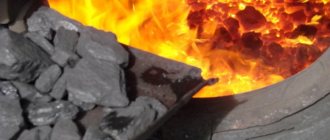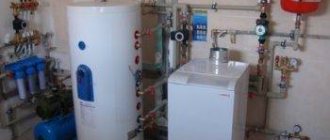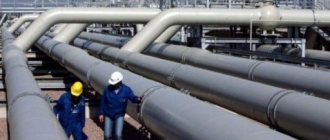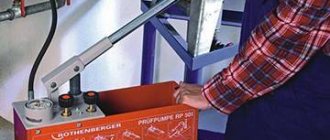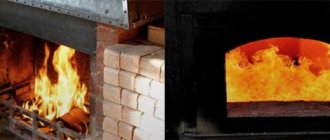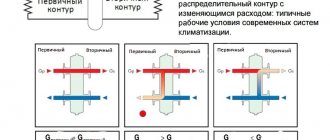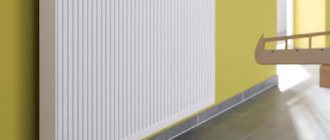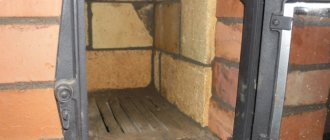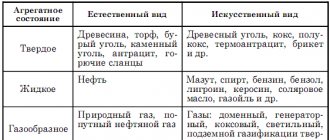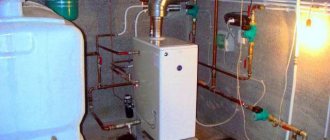Due to the steady increase in the cost of electricity and natural gas tariffs, the use of various types of solid fuel for heating is becoming increasingly important. It is not surprising that owners of private houses strive to find other options for economical heating and install heat generators that run on wood. But before purchasing a solid fuel boiler, every homeowner wants to understand what the daily operation of such a heat source will cost. To do this, first of all, you should determine the consumption of firewood for heating the house, which will be discussed in this article.
Calculator for calculating solid fuel consumption for a furnace
Wood stoves, even with the current variety of boiler equipment, do not lose their popularity. Some people do not have the opportunity to install a gas line to their house, others have firewood or other wood as practically free fuel, and others simply do not want to move away from old traditions. Be that as it may, stoves are not only repaired and restored, but also new ones are built - master stove makers are not idle.
Calculator for calculating solid fuel consumption for a furnace
Owners of old houses with stoves, thanks to many years of practice, are already well aware of how much firewood or other solid fuel they will need for a month or for the entire season. For those who just want to get a stove, this question will probably be very interesting. We hope that the proposed calculator for calculating solid fuel consumption for a furnace will serve them well.
Prices for solid fuel for the stove
Below, under the calculator, a brief rationale for the calculations will be given.
Calculator for calculating solid fuel consumption for a furnace
Explanations for calculating fuel consumption
- The starting parameter for the calculations will be the thermal power of a brick or metal stove. As a rule, master stove makers who build certain models know what heating potential is inherent in their “brainchild”. The power of the stove is selected in advance - it must correspond to both the region of residence (or rather, its climatic characteristics) and the heated area of the house.
- Unfortunately, any solid fuel stove cannot boast of very high efficiency - part of the thermal energy, sometimes quite significant, simply literally “flies down the drain” along with the combustion products. This forces adjustments to be made to the calculations. By default, the calculator shows an efficiency of 70%, but the user can enter his own value.
- Solid fuel is very heterogeneous in its heat transfer - this applies to firewood and other types: coal, peat, briquettes. Thermal indicators for different types of wood and types of solid fuel are also taken into account in the calculator. If desired, the user can select one direction or another of calculations in the “Calculate for:” field.
- If the calculation is carried out for firewood, then it is necessary to indicate the degree of drying - for wet firewood that has not been dried for a year, the heat transfer may be 15-20% lower, and then more fuel will be required.
- There is a slight gradation in the final result - if firewood is usually measured and purchased in cubic meters, then for bulk fuels the weight equivalent is usually used - kilograms or tons. In the results obtained, one number is given, but it should be understood as cubic meters for firewood, or as tons if the calculation is carried out for other types of solid fuel (for simplicity, a “hint” is given in each result in parentheses).
Surely someone may be very surprised by the results obtained. However, it should be understood that the calculation is based on the most unfavorable weather conditions. But in practice, in winter there are very warm days, up to a thaw, and consumption can become significantly lower. But this will create a guaranteed reserve for any unforeseen cases! And a few years will pass - and a certain regime for firing the stove will develop, and the owners will already know, even without calculations, how much firewood they should prepare for the winter.
What do future stove owners need to know about firewood?
If you want to have your own wood-burning stove, then you will have to learn how to choose, prepare and store firewood correctly. There are a lot of interesting nuances in these questions, information about which can be gleaned from the publication of our portal “Which firewood is best for heating”
Coal heating equipment
Coal ovens
A conventional stove can only heat one or two rooms, even if you use coal rather than wood to heat the house. True, it can be improved by embedding a heat exchanger for water heating inside the brickwork. The stove is good in its own way, but sometimes it can be dangerous due to the fact that it provokes carbon monoxide poisoning.
Important. The stove chimney valve can be closed only after the coal has completely burned and the flames have disappeared from the firebox. For heating a cottage with coal, a heating unit such as a boiler is much more efficient, reliable and safe.
For heating a cottage with coal, a heating unit such as a boiler is much more efficient, reliable and safe.
Coal solid fuel heating boilers
The diagram shows the design of an improved coal boiler
The design of a coal heating boiler is simple, but very effective. Its cast iron heat exchanger and powerful grate are resistant to burnout and corrosion. Even the simplest of these devices have been regularly heating homes for many decades. But still, old-style boilers are inferior in performance and heat transfer to their current competitors.
The operating principle of a heating boiler looks like this:
- as soon as a fire is lit in the firebox, a draft is created in the chimney and air is drawn into the fuel chamber;
- the coal heats up and partially burns;
- gaseous products of coal combustion are mixed with the secondary air supplied inside and finally burn;
- the resulting gases give up their temperature to the coolant and are then discharged through the chimney.
Modern coal-fired heating boilers consistently heat residential premises and outbuildings. They consume 2 times less fuel compared to outdated models. Advanced technologies have improved not only the design and design of heating units, but also the very principle of fuel combustion. As a result, now the homeowner does not have to load the next portion of coal into the boiler several times a day and remove accumulated slag.
The enlarged combustion chamber is designed for simultaneous loading of a large amount of coal, which gradually burns out over 6–12 hours. Forced air injection promotes the most complete combustion of fuel. Thanks to this, coal consumption for heating the house is significantly reduced.
Especially for automatic models of heating equipment, it is recommended to purchase eco-pea coal, which has optimal dimensions and is free from dust.
The large bunker of the automated heating boiler ensures long burning of coal
Automated fuel supply from the bunker to the boiler “frees the user’s hands.” He becomes free from the obligation to constantly monitor the operating heating device. The capacity of the bunker is enough for non-stop burning of coal for a week.
Reviews of coal heating demonstrate how satisfied users are with the practicality of automated coal boilers. It is very convenient to start the boiler at the beginning of the heating season, and throughout the winter just add coal to the bunker as it is emptied. You also don’t have to remove ash and slag too often, just a couple of times a month.
Lighting coal for heating in a boiler, especially anthracite, can be difficult for an unaccustomed person. First, the boiler is heated with wood or a special mixture, and then fine coal is added little by little. When combustion becomes stable, you can add anthracite in large portions. Exactly how much and how often will depend on the boiler model and will be more accurately determined in the practice of its use.
Do not use gasoline to ignite coal in a heating boiler!
What to do if the electricity in the house goes out? In this case, the automatic supply of coal to the fuel chamber of the boiler will be stopped. At the same time, the circulation pump will stop working, and water will stagnate in the heat exchanger. But the boiler will not boil, because coal combustion will go into low mode. Then, when power is restored, the coal will reignite.
Solid fuel boiler maintenance
Boiler maintenance measures boil down to the need to clean the heat exchanger and smoke exhaust channels. Soot settles on their surfaces, and this phenomenon reduces the efficiency of the heating unit by 15%. The frequency of cleaning a coal heating boiler can vary: old cast iron models have to be cleaned 2-3 times per season, and modern ones once every 2 years.
For unhindered maintenance of the boiler, there must be free access to it in the room where it is installed.
How to calculate wood consumption for heating
Due to the steady increase in the cost of electricity and natural gas tariffs, the use of various types of solid fuel for heating is becoming increasingly important. It is not surprising that owners of private houses strive to find other options for economical heating and install heat generators that run on wood. But before purchasing a solid fuel boiler, every homeowner wants to understand what the daily operation of such a heat source will cost. To do this, first of all, you should determine the consumption of firewood for heating the house, which will be discussed in this article.
a*b*c=V cubic meter
It is much more difficult if the woodpiles are folded into an irregular geometric figure or chaotically, then either fold them into the correct figure, or, armed with a tape measure, paper and pencil, transfer this figure to a sheet of paper, and then calculate the volume using formulas.
Formulas must be taken from the geometry section, where volumes are calculated.
Cubic meters - this will be the volume of the stacked woodpile, but it must be calculated immediately in meters, according to all parameters.
By the way, in the last photo the firewood is stacked in the shape of a paraboloid, so the formula for the calculation will be:
Initial data for calculation
The calculations themselves, which determine the amount of wood burned in the boiler firebox, are quite simple. The difficulty is to choose the right source data to perform the calculations. Of course, the easiest way is to use some online calculator that is posted on various Internet resources, and thus find out for yourself the rates of firewood consumption for heating your home. There is only one way to check the correctness of the calculation: do it yourself, manually.
For this reason, we initially suggest going this way, then you will be confident in the result. But you can check its correctness using several online calculators. Below we will present the methodology and at the same time, as an example, we will calculate the consumption of the amount of firewood for heating a house of 100 m2. But first of all, the initial data, here is their list:
- the type of wood that is supposed to be used to heat the premises;
- their degree of humidity;
- Efficiency of a solid fuel stove or boiler;
- thermal power required to heat the building.
Those who have ever used a stove have probably noticed that when burning wood from different trees, different amounts of heat are released. For example, birch logs produce more heat than poplar or pine. This happens because different tree species have different densities and calorific values. Also, the amount of firewood per 1 kW of thermal energy depends on its humidity. The higher it is, the more heat is spent on evaporating water from the fuel, and less is left for heating the house. As a result, more wood will be needed to heat the home.
The efficiency of using the energy contained in wood depends on the efficiency of a particular heat source. For example, a fireplace or a conventional stove releases a lot of energy into the atmosphere along with combustion products, respectively, their efficiency does not exceed 60%. Another thing is a solid fuel or pyrolysis boiler, whose efficiency can reach 80%; these features must be taken into account when calculating the cost of heating a private house.
The table below provides reference data on the calorific value of 1 m3 of certain types of wood at a certain humidity.
Note. The table shows the values for a “net” cubic meter of each type of fuel; the cubic capacity of firewood must be calculated using 1 m3 of logs or logs stored in storage, which will be discussed below.
The value of the thermal power required to heat a home is best taken according to the calculation made by specialists during the design of the house. But often homeowners do not have such data; in this case, the amount and cost of firewood for heating can be calculated based on the average value of the required power. It is determined by a well-known method: heating 10 m2 of premises requires 1 kW of heat under the most unfavorable conditions, and on average per season - 0.5 kW. That is, the average standard for a house with an area of 100 m2 will be 5 kW/h.
Fireplaces and fireplace inserts cost savings, highest quality and convenient purchase
Fireplaces and fireplace inserts for heating – features of selection and application:
When choosing a fireplace, you should understand that it is primarily a heating device. That is why its acquisition should be taken with the utmost seriousness.
It is important to consider the technical capabilities, purpose and design features of the models you choose. You also need to remember that fireplace inserts from different manufacturers differ significantly from each other in precisely these indicators
Despite this, externally, fireplace inserts can be very similar.
How to reduce home heating costs?
Fireplace inserts can perform the function of heating equipment: be both the main and auxiliary source of heating in the house. But not every fireplace insert can heat a house. Fireplace inserts can be either for decorative purposes (with intermittent combustion) or with a heating function (continuous combustion).
Two types of functional fireplace inserts will help you save on heating your home:
- – with air heating;
- – with water heating.
To heat a water heating system, you need to buy a fireplace with a water circuit. It will perform the work of a solid fuel boiler and fireplace at the same time. Most often, a water fireplace is used in a system with another heat source, for example, a gas or electric boiler. When the fireplace is operating, the other source is automatically switched off. A fireplace with a water circuit can also independently heat the entire house. This saves money on heating your home.
The efficiency of a fireplace-based air heating system depends on many factors:
If it is not possible to install a traditional wood-burning fireplace, and the dream of home comfort with a fireplace does not leave you, we suggest buying an electric fireplace with a 3D flame effect. For country houses or cold rooms, free-standing fireplaces and stoves that do not need finishing are ideal. We can also offer you stoves for baths and saunas.
To purchase a fireplace and order its installation:
You can send us a house plan by email, or order a visit from our specialist to take measurements on site. We will make you a free commercial offer for a fireplace heating system, which will indicate all the necessary equipment.
A good fireplace can really heat up your home quickly. You won't turn your beautiful living room into a boiler room, since you won't have to add wood to the fireplace every hour. Our fireplace inserts allow one load of wood to burn for a long time, even up to 12 hours.
You can buy fireplaces, fireplace inserts in Ukraine or other products presented by us by ordering them by phone or through an online store. In all cities of Ukraine we deliver by transport service.
Our main advantages:
- – individual approach.
- – only high-quality goods.
- – direct deliveries from the manufacturer.
- – official warranty from the manufacturer for up to 10 years.
- – shortest delivery and installation times.
- – affordable prices for fireplace inserts.
Calculation procedure
So, to find out the volumetric consumption of firewood in a solid fuel boiler or stove for 1 day, you need to use the formula:
V = 24Q / (q x 0.01 efficiency) , where:
- V – amount of firewood consumed per 1 hour, m3;
- Q – required power to heat the building, kW;
- q is the calorific value of a given type of wood with a certain moisture content, taken from the table, kW/m3;
- Efficiency is the efficiency of the boiler installation as a percentage.
If we assume that in our example the home will be heated by a solid fuel pyrolysis boiler with an efficiency of 75%, loaded with dried pine logs, then the formula for calculating firewood will take the following form:
V = 24 x 5 / (2166 x 0.01 x 75) = 0.074 m3
Important! In order to correctly calculate the consumption of firewood in a pyrolysis boiler, it is necessary to take into account the peculiarities of its operation. An efficiency of 75-80% is used in the formula when the firewood has a moisture content of no higher than 25%. If this figure is higher, then the efficiency of the heat generator is reduced to 70%, as with traditional units.
Then it is not difficult to calculate how much fuel is needed for 1 month: 0.074 x 30 = 2.22 m3. But this result is not final, since the formula takes into account the value of the calorific value for a “clean” cubic meter, and in reality the fuel in the woodpile takes up more space due to the packing density. To correctly calculate firewood in cubes, you need to determine the number of storage meters.
GOST 3242–88 will help you carry out these calculations; it sets out a standard according to which stored firewood should be measured, stock meters calculated, and then converted into dense measures - cubic meters. The conversion is carried out by multiplying the volume of the woodpile by the full wood coefficient. The table below shows the values of this coefficient for wood of various configurations.
Since in our case there is an inverse problem, the previously obtained volume of fuel must be divided by one of the coefficients corresponding to real conditions.
For example, let’s take chopped firewood 0.5 m long, then for coniferous species you should select a value of 0.73. We finally find out the real consumption of solid fuel from dry pine in 1 month for a private house with an area of 100 m2:
2.22 m3 / 0.73 = 3.04 m3
Answers from experts
New:
1 cart (4 cubes/4t. rubles) economy, 2 from the belly. But this is provided that there are no cracks, the winter frames are perfect, the ceiling is insulated, and the Russian stove is in working order.
Rada Simbireva:
!0 cu. enough meters. This is approximately 4-5 thousand rubles, depending on the area and the presence of forests in the area.
Lyudmila Demina (Malakhova):
Well. and the men went... Buy a car of wood and burn it, and then draw your own conclusions!
INFERNO:
The amount of firewood depends not on the area of the house, but on its volume. with a ceiling height of 2 meters and 2.5 meters, the difference in the volume that needs to be heated is 100 cubic meters, which is decent. In addition, you need to know what material the house is made of, its heat-retaining ability, and the characteristics of the heating device (stove or boiler). The price of wood depends on the type of wood, sawn or chopped. We sell chopped birch from 1200 to 2500 per cubic meter, depending on the distance from the city and the number of wealthy homeowners in the area.
Nadezhda R:
If we assume that 6 m3 can be stored in a car, then for the winter you need 2 cars, i.e. 12 m3. Our car of firewood costs 6 thousand. Yours may be cheaper...
Elena the beautiful:
If with coal, then 3 cubic meters is enough. Machine-5-6 cu. costs 5-6 thousand. Tambov region. It depends on what kind of winter it will be, of course.
ZhenYok:
it depends on what kind of house it is, big or small, warm or cold, and also on the type of wood, pine burns quickly, gives little heat, aspen is the same, the best choice is birch. I have a five-walled house, the house is closer to a warm one, I need about 1 car (about 5 cubic meters) of birch firewood, this is the minimum, pine so at least two cars
irina gurlova:
And where do you live? In winter it’s +5 here, but there are places that are even colder.
Cyber Phantom:
I wonder how to compare the units “cubic meters” and “little by little”? Apparently you need to know the area of the heated room.
Eugenio DJ:
Depends on how big the stove is. 4-5 cubes are enough.
Tiger:
You need six cubes.
wavan:
365 if you throw it up every night
Antonina Smirnova:
This depends on the winter temperature, the heated area, the quality of the firewood and the length of the heating period. I don't know your details. in Siberia, my mother bought 30 cubic meters of birch firewood. in the Far East, where winter is much shorter, we bought 15 cubic meters. - taking into account that we had a farm and had to cook food for the animals.
SpecWood -:
There are many parameters to take into account, here’s a calculator:
Firewood consumption rates for stove heating
ADMINISTRATION OF THE NOVGOROD REGION
dated October 29, 2010 N 529
ON APPROVAL OF THE METHOD FOR CALCULATING THE SIZE OF THE ANNUAL NEED FOR SOLID FUEL, GAS AND ELECTRIC ENERGY FOR HEATING HOUSES WITHOUT CENTRAL HEATING
____________________________________________________________________ Lost force on the basis of Decree of the Government of the Novgorod Region of August 18, 2017 N 284, which came into force on the day following the day of official publication (published on the Official Internet portal of legal information https://www.pravo.gov.ru - 22.08. 2017). _____________________________________________________________________
1. Approve the attached methodology for calculating the annual demand for solid fuel, gas and electricity for heating houses that do not have central heating (hereinafter referred to as the methodology).
2. Publish the resolution in the newspaper “Novgorod Vedomosti”.
Head of the regional administration A.A. Shalmuev
Approved by Resolution of the Regional Administration dated October 29, 2010 N 529
Capacity 131
The next car is called ZIL 131. It is an all-terrain vehicle with all-wheel drive. It was intended for the army.
https://www.drovavoz.ru/drov-v-zile.html - link
| "Gazelle" | |
| Length: 2.8-3.2 m (extended options up to 4.5 m exist) Width: 1.8 - 1.9 m Height: 1.7 - 2 m Volume: 9-11 m3 Load capacity: 1.5 - 1.7 tons | Based on their main consumer qualities (tonnage, volume, overall dimensions), various models of domestic and imported trucks can be classified as Gazelle class vehicles. The cargo compartments of these vehicles may differ slightly in overall dimensions and, accordingly, volumes. Cars of this class are actively used on intracity and intercity routes of short and medium range (500-700 km). Technical characteristics allow us to guarantee a fairly high average speed (up to 100 km/h) and the cabin layout provides space for one or two passengers (forwarders). The tilt version of the cargo compartment suggests the ability to open the cargo compartment and get an open cargo compartment. The car can be equipped with fastening belts and other additional equipment (elevator, hard sides). |
| "ZIL-Bychok" | |
| Length: 3.7 m Width: 2.1 m Height: 2.2 m Volume: 17 m3 Load capacity: 3.5 tons | Based on their main consumer qualities (tonnage, volume, overall dimensions), various models of domestic and imported trucks can be classified as ZIL-Bychok class vehicles. The cargo compartments of these vehicles may differ slightly in overall dimensions and, accordingly, volumes. Cars of this class are actively used on intracity and intercity routes of short and medium range (500-700 km). Technical characteristics allow us to guarantee a fairly high average speed (up to 80 km/h); a small axle load allows this vehicle to drive unhindered in areas with restrictions on the entry of freight vehicles |
| "ZIL" | |
| Length: 3.5 - 4 m Width: 2-2.3 m Height: 2.45 m Volume: 14-21 m3 Load capacity: 5 tons | Based on their main consumer qualities (tonnage, volume, overall dimensions), various models of domestic and imported trucks can be classified as ZIL class vehicles. The cargo compartments of these vehicles may differ slightly in overall dimensions and, accordingly, volumes. Cars of this class are actively used on intracity and intercity routes of short and medium range (500-700 km). Often used for transporting personal belongings and moving. |
How many cubic meters of firewood are there in ZIL
The Internet is often asked how many cubic meters of firewood a ZIL can hold. But there are no good articles on this topic. We decided to be the first and answer how much can fit in the 130th.
It should be said that there are several modifications of ZIL that are used to transport firewood. This could be the 131st, the flatbed 130th, or the ZIL Boat dump truck marked 555. And the firewood can also be stored in the 554th. This is also a dump truck, but with a regular square body.
In terms of carrying capacity, all vehicles from the plant named after. Likhachev are the same. They take on board up to 5 tons of cargo. If the driver does not spare the car, it will load 6.5 tons. Based on the weight of the wood, we can say that the car can take away 7-8 cubic meters of birch.
All ZIL models have different platform sizes. Accordingly, different amounts of wood fit into them.
PREMIUM BIRCH FIREWOOD
birch firewood has a moisture content of about 15% and is ideal for use as fuel for a fireplace, bathhouse or barbecue.
Birch firewood of this type belongs to the premium firewood category. It is not slightly more expensive (you can find out the cost here) than other types of firewood, due to the fact that each log is pre-washed under high pressure and dried in a special chamber. Humidity of 15% allows you to quickly ignite a fire, is guaranteed to reduce the level of soot and deposits in pipes, and ensures a high and stable temperature during combustion.
Birch firewood, hand-picked, in addition to the purely utilitarian purpose of heating, can and does serve in many country houses as interior decoration. Birch firewood (logs) create a feeling of comfort and antiquity
How much firewood is in UAZ 3151 “goat”
This model is widespread. I drove it for firewood with the interior disassembled. I filmed everything, even the back seats. This way it held about 2 cubes.
But the UAZ cannot carry so much. This machine performs well under a load of 1 m3. With a larger load, there is a high probability of getting stuck during muddy times. And the load on springs and wheel bearings from 1.5 cubic meters is quite large.
You can fit 1.5-2 cubic meters into a UAZ 3151. Of course, if you don't mind the car.
https://www.drovavoz.ru/drova-uaz.html - link
From autumn to spring.
According to the norm for heating from autumn to spring, every 10 square meters. m of living space, with normal thermal insulation, about 1 cubic meter of firewood is required, taking into account the fact that the firewood is not wet aspen, which, as is known, does not burn without kerosene. As for the bathhouse, it all depends on how committed you are to steam, broom and other soapy procedures: after all, the bathhouse can be heated once, twice, or three times a week. But if we stop at two furnaces, then I undertake to say that with 5 cubic meters a bathhouse can be heated for a whole year.
